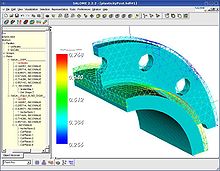Computer-aided engineering (CAE) is the broad usage of computer software to aid in engineering tasks.[1][2][3] It includes computer-aided design (CAD), computer-aided analysis (CAA), computer-integrated manufacturing (CIM), computer-aided manufacturing (CAM), material requirements planning (MRP), and computer-aided planning (CAP).[4][5][6]
CAE systems can provide support to businesses. This is achieved by the use of reference architectures and their ability to place information views on the business process. Reference architecture is the basis from which information model, especially product and manufacturing models.
The term CAE has also been used by some in the past to describe the use of computer technology within engineering in a broader sense than just engineering analysis. It was in this context that the term was coined by Jason Lemon, founder of SDRC in the late 1970s. This definition is however better known today by the terms CAx and PLM.[citation needed]
CAE fields and phases CAE areas covered include:
- Stress analysis on components and assemblies using FEA (Finite Element Analysis);
- Thermal and fluid flow analysis Computational fluid dynamics (CFD);
- Kinematics;
- Mechanical event simulation (MES).
- Analysis tools for process simulation for operations such as casting, molding, and die press forming.
- Optimization of the product or process.
- Pre-processing – defining the model and environmental factors to be applied to it. (typically a finite element model, but facet, voxel and thin sheet methods are also used)
- Analysis solver (usually performed on high powered computers)
- Post-processing of results (using visualization tools)
CAE in the automotive industry
CAE tools are very widely used in the automotive industry. In fact, their use has enabled the automakers to reduce product development cost and time while improving the safety, comfort, and durability of the vehicles they produce. The predictive capability of CAE tools has progressed to the point where much of the design verification is now done using computer simulations rather than physical prototype testing. CAE dependability is based upon all proper assumptions as inputs and must identify critical inputs (BJ). Even though there have been many advances in CAE, and it is widely used in the engineering field, physical testing is still used as a final confirmation for subsystems due to the fact that CAE cannot predict all variables in complex assemblies (i.e. metal stretch, thinning).




 LibreOffice
LibreOffice Firefox
Firefox
No comments:
Post a Comment